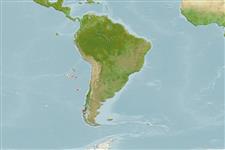Teleostei (teleosts) >
Acropomatiformes (Oceanic basses) >
Epigonidae (Deepwater cardinalfishes)
Etymology: Epigonus: Greek, epi = over, in front + Greek, gonio = angle (Ref. 45335).
Environment: milieu / climate zone / depth range / distribution range
Ecology
Marine; bathydemersal; depth range 230 - 340 m (Ref. 31632). Deep-water
Southeast Pacific: seamount in the Nazca chain. High Seas only.
Size / Weight / Age
Maturity: Lm ? range ? - ? cm
Max length : 23.8 cm SL male/unsexed; (Ref. 31632)
Short description
Identification keys | Morphology | Morphometrics
No opercular spines. 8 spines on first dorsal fin. No teeth on tongue. Last spine of the first dorsal fin is considerably removed from the next to last spine and is not joined to it by a membrane (Ref. 31632).
A mesobenthic-pelagic species living mainly above the bottom (Ref. 31632). No length type given but assumed to be SL.
Life cycle and mating behavior
Maturity | Reproduction | Spawning | Eggs | Fecundity | Larvae
Abramov, A.A., 1992. Species composition and distribution of Epigonus (Epigonidae) in the world ocean. J. Ichthyol. 32(5):94-108. (Ref. 31632)
IUCN Red List Status (Ref. 130435: Version 2024-2)
Threat to humans
Harmless
Human uses
Tools
Special reports
Download XML
Internet sources
Estimates based on models
Preferred temperature (Ref.
123201): 4.4 - 13.3, mean 10.6 °C (based on 40 cells).
Phylogenetic diversity index (Ref.
82804): PD
50 = 0.5000 [Uniqueness, from 0.5 = low to 2.0 = high].
Bayesian length-weight: a=0.00646 (0.00275 - 0.01515), b=3.10 (2.89 - 3.31), in cm total length, based on LWR estimates for this (Sub)family-body shape (Ref.
93245).
Trophic level (Ref.
69278): 3.6 ±0.5 se; based on size and trophs of closest relatives
Resilience (Ref.
120179): Medium, minimum population doubling time 1.4 - 4.4 years (Assuming tm=2-4).
Fishing Vulnerability (Ref.
59153): Low vulnerability (19 of 100).
